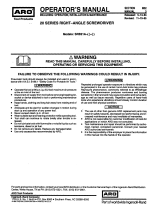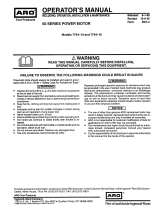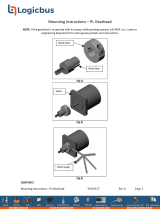MAINTENANCE SECTION
20.
21.
22.
23.
24.
25.
26.
27.
28.
29.
30.
31.
32.
Install the Bit Holder Assembly onto the Cam Guide
in the Gear Case.
The Taper Ring Retaining Ring (15 or 17) has a
round edge side and a sharp edge side. Install the
Taper Ring Retaining Ring, sharp edge side first, into
the groove on the Bit Holder.
There are four grooves on the Bit Holder. The
fourth groove from the bit end is for Push to Start
Models. The third is for Throttle Lever Start
Models.
For Throttle Lever Start Models, place the Spindle
Washers onto the Bit Holder.
Place the Clutch Spring (14 or 16) and the Clutch
Spring Plate (13 or 15) over the Bit Holder.
Fit the two notches at the rear end of the Gear Case
Assembly into the Gear Case Jig part no.
EP151ON-J37. Screw the Clutch Housing (12) par-
tially into the Gear Case.
This is a left-hand thread.
At the middle of the Clutch Housing threads, apply
Loctite Threadlocker 3 Bond 1406 (R)* to about
three threads. Push down and rotate the Bit Holder
until it engages the Cam Guide. Hold in place.
Screw the Clutch Housing in completely.
Using an open end torque wrench on the flats of the
Clutch Housing, tighten the Clutch Housing to 28.5
Nm.
Apply grease to both ends of the Clutch Pilot Rod (36
or 38) and insert it into the Gear Case.
For Throttle Lever Start Models, inspect the clear-
ance of the Bit Holder Assembly.
Touch the end of
the Clutch Pilot Rod and push on the Bit Holder As-
sembly. If the Clutch Pilot Rod is moved by the Bit
Holder at this time, add additional spacers.
Install the Bit Retainer Retaining Ring (l0), sharp
edge side first, into the second groove from the bit
end of the Bit Holder.
Apply grease to the holes of the Bit Holder and insert
the two Bit Retaining Balls (17 or 19) into the holes.
Apply grease to one end of each Clutch Adjusting Pin
(11) and insert the three Pins into the Clutch Housing.
Apply grease to the other end of each Clutch Adjust-
ing Pin and the threads of the Clutch Housing. Screw
the Clutch Adjusting Ring (4) onto the Housing.
Install the Bit Retainer Sleeve (9), the Bit Retainer
Spring (8) and the Bit Retainer Collar (7) onto the Bit
Holder.
33.
34.
35.
36.
37.
38.
Using a thin blade screwdriver, install the Front Bit
Retainer Retaining Ring (6).
Unclamp the Gear Case Jig from the vise and turn it
over to remove the Clutch and Gear Case Assembly.
Hold the Gear Case Shield to keep the Gears in place.
Lift the Motor slightly and slide the Gear Case onto
the Motor with the Ground Screw hole adjacent to the
ground wire.
Attach the ground wire to the Gear Case with the
Ground Screw (74) and Washer (75). Tighten to 4
KG-cm.
Turn the Gear Case until the notch in the Gear Case
matches the tab in the Housing.
Completely insert the ground wire into the groove in
the Housing.
Adjusting the Brake Timing
1. Insert a .65mm thick gauge or pin gauge between the
Pilot Rod Adjusting Screw (55) head and the Shut-
off Switch. Push the Bit Holder. The Shut-off
Switch should not click.
2. Insert a .80mm gauge and push the Bit Holder.
The Shut-off Switch should click.
3. Adjust the Pilot Rod Adjusting Screw if necessary
using the two adjusting spanner wrenches.
4. For Throttle Lever Start Models, there is no need
to push the Bit Holder. Slide the gauges between the
Pilot Rod Adjusting Screw and the Throttle Lever
(76).
Assembly of the Tool
1.
2.
3.
4
5.
6.
7.
For Push to Start Models, make sure the ground
wire is inserted in the groove in the Housing.
For Throttle Lever Start Models, make sure the
Ground Wire is between the Motor Assembly and the
Housing.
Snap the Housing halves together.
For Throttle Lever Start Models, insert the
Throttle Lever Pin (78) into the Housing. Insert the
Throttle Spring (77) into the Throttle Lever. While
compressing the Throttle Spring, install the Throttle
Lever onto the Throttle Lever Pin.
Snap the Housing
halves together.
Install the Housing Screws (80 or 83) into the Hous-
ing and tighten to 4 KG-cm.
Slide the Flange (2) onto the Housing. Screw the
Retainer Coupling (1) onto the Housing until it clicks
into place.
These are left-hand threads.
Attach the Power Cord (8 1 or 84).
18

























